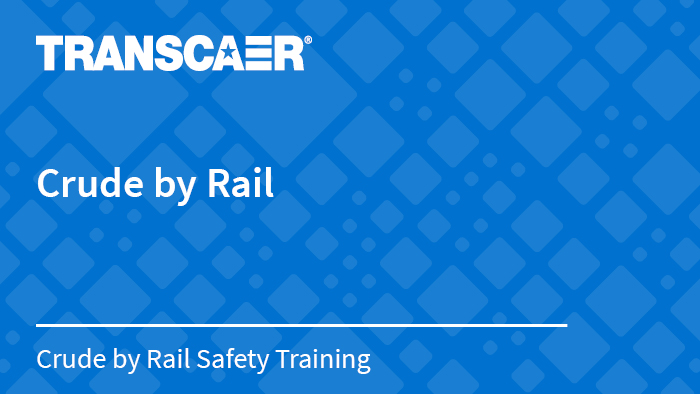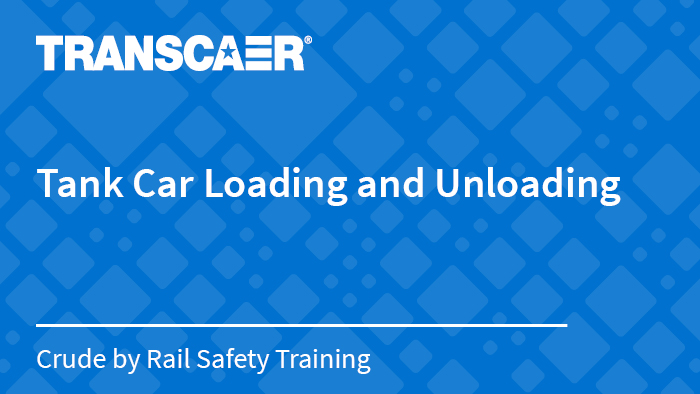The American Petroleum Institute (API), the Association of American Railroads (AAR) and their member companies have worked to create a general awareness educational video and resources for first responders. The free course can be viewed online here. Or it can be presented in person upon request. Requests for in-person course instruction should be directed to your TRANSCAER State Coordinator. The course is meant to provide the specific information first responders need to know before approaching an incident involving crude oil moved by rail.
I.
Crude by Rail
This video provides general guidance on several key topics: moving crude oil by rail, the type of tank cars that carry crude oil, and the characteristics of crude oil. It also covers the Rescue, Exposure, Containment, Extinguish, Overhaul, Salvage (RECEOS) strategies that should be considered if crude oil is present, spill response and firefighting considerations, and the need for structured incident management.
II.
Tank Car Loading and Unloading
Over 99.99% of hazardous materials are loaded, shipped, transported, and unloaded safely. This video covers non-accident releases (NARs), recommended practices that are applicable to all types of tank cars, proper securement practices for general service tank cars, and proper securement practices for pressure tank cars.
III.
Association of American Railroads Pamphlet 34
This pamphlet presents the AAR’s general guidelines for the selection of tank cars and recommended procedures for loading and unloading tank cars.
Downloads:
IV.
2022 Field Guide for Tank Cars - 4th Edition
This field guide is intended to be used by emergency responders and others involved with railroad tank cars. It provides information on the types of tank cars, safety systems, stenciling, and markings of tank cars used to transport regulated (hazardous materials/dangerous goods) and nonregulated commodities.
Downloads:
V.
US DOT - Commodity Preparedness and Incident Management Reference Sheet
Developed by PHMSA in conjunction with experts from the hazmat emergency response community, railroads and industry, this document provides emergency response organizations with a standard incident management framework based on pre-incident planning and preparedness principles and best practices. The reference sheet covers transportation safety and precautions, hazard assessment and risk, rail safety procedures, logistics, and the tools, equipment and resources necessary to prepare for and respond to crude oil rail transportation incidents.
Downloads:
VI.
US DOT Chart 16 - Hazardous Materials Markings, Labeling, and Placarding Guide
This chart provides an overview of hazardous materials markings, warning labels, and placards for the class 1 (explosives), class 2 (gases), class 3 (flammable liquid and combustible liquid), class 4 (flammable solid, spontaneously combustible and dangerous when wet), class 5 (oxidizer & organic peroxide), class 6 (poison (toxic) and poison inhalation hazard), class 7 (radioactive), class 9 (miscellaneous), and dangerous. Refer to 49 CFR, Part 172: Marking - Subpart D; Labeling - Subpart E; Placarding - Subpart F.
This document is for general guidance only and should not be used to determine compliance with 49 CFR, Parts 100-185.
Downloads:
VII.
Crude by Rail Educational Resources
The HAZMAT FLIC app provides the on-scene incident commander with pertinent guidance materials for managing emergency responses for high hazard flammable train and liquid petroleum pipeline emergencies. It is provided by the National Fire Protection Association.
The app features instant access to two Fire Protection Research Foundation reports:
• Liquid Petroleum Pipeline Emergencies (LPPE) On-Scene Incident Commander Field Guide
• High Hazard Flammable Trains (HHFT) On-Scene Incident Commander Field Guide
Downloads:

